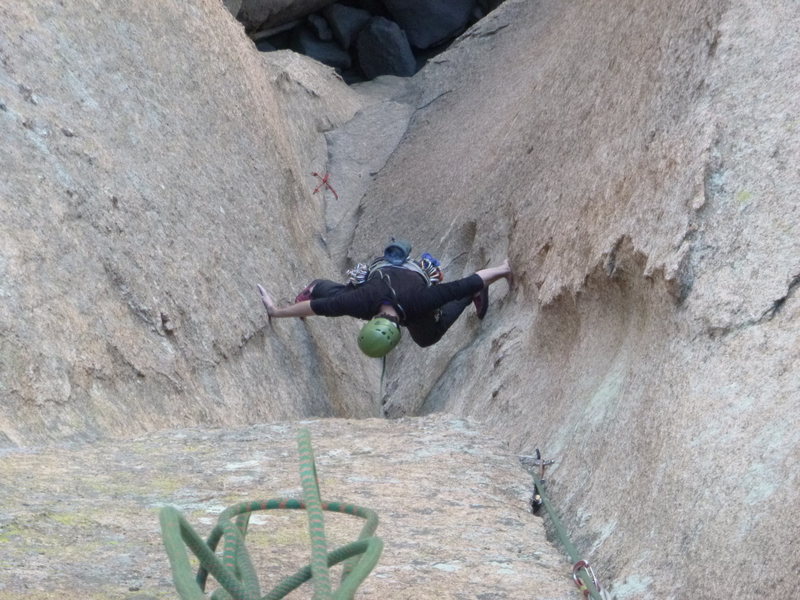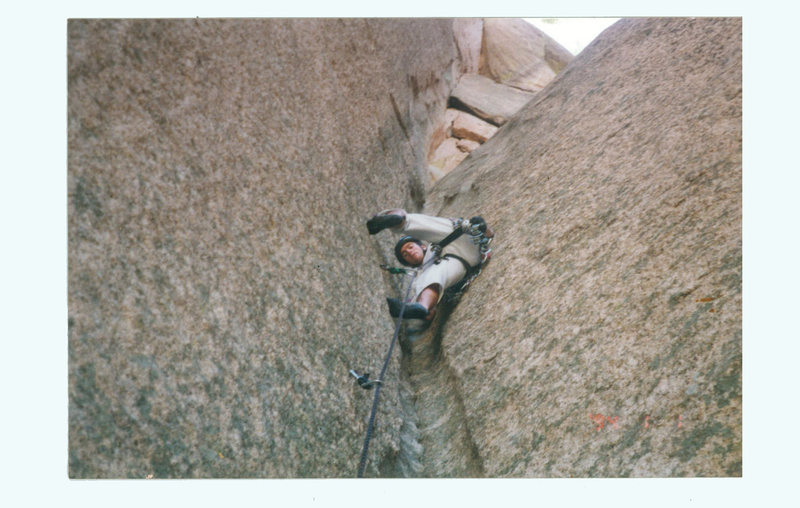



 Avg: 3.9 from 31
votes
Avg: 3.9 from 31
votes
 Access Issue: Read this Access Note!
Details
Access Issue: Read this Access Note!
Details
An extraordinary climb, this is perhaps the best trad route of its grade in the Dragoons. It was one of the "Three Sisters" climbed by RR and Chip in the summer of 1980 in the corridor between the main Rockfellow Dome and Chay Desa Tsay: three steep and forbidding crack systems rising out of the darkness and disappearing into the slice of sky above. This and other routes in the corridor are great summer routes because they rarely see sun, except for their summit pitches. (As of this writing, though, there is a Forest Service peregrine falcon closure from March 1 through June 30, which apparently is an annual restriction).
Sound of One Hand Thrashing is the best of the Three Sisters. It requires a variety of skills, including Dragoon groove climbing, technical stemming, creative use of gear, and steady nerves. Most pitches have some climbing above questionable gear. When we summitted, we were greeted by a group of vultures eyeing us from the top of Bastion. Eerie.
For decades, after my and Herb North's ascent in 1981, I called this line "Coming to Grips," and used that name in raving about the route to many an ear. When I saw it named differently in Bob Kerry's 1991 guide, I wondered how he could have gotten the name of such a classic route wrong. I later got the chance to post the line here with the name that had been stuck in my head for so long. Recently, at a reunion of sorts, Chip and RR gently informed me that this route has all along been called Sound of One Hand Thrashing. In our mutual haze of senility, I'm not sure mine is worse than their's, but it was two to one.
Begin by climbing a short section of 5.9 to the base of the dihedral. Clip the bolt and climb the nearly flawless corner, past a pin, to a three-bolt belay (5.11c/d). (2) Continue up the groove/corner above past two bolts (5.10d) to a belay from gear maybe 20 feet below a roof. There were two fixed nuts at the belay when we did it. (3) Wild climbing on slightly overhanging rock traverses left and up to a bolt. Stiff climbing past the bolt (5.11b) leads to an obvious traverse left to a ledge and thankfully lower angle rock. Gear belay. (4) Climb a somewhat short 5.8 pitch to a gear belay just before the climbing gets harder and spookier. (5) Continue up the crack/groove system above, stepping left. Above are the pitch's hardest moves, which slowly let up as you get closer to the summit jug (5.11a).










Tucson/DMR
Modern climbing gear protects this climb well enough that the R rating is probably not warranted, however, all but one of the pitches have some tricky pro and demanding climbing.
We felt that stoppers, singles to .75 camalot, doubles of #1-#3, and one #4 camalot would work well for protecting this climb. All pitches are under 100'.
Thanks to Dave Merin and the ASCA, all of the bolts have been replaced with stainless steel sleeve bolts. The route is in prime condition now.
If you are interested in a topo for this route, feel free to PM me and I will send you one. You can also get one by registering at the toofasttopos website. Nov 8, 2012
In terms of quality, I think it is in the same ballpark as Abra...!!!
Save for the low angle OW on pitch 4, there is challenging climbing bottom to top, on incredible rock. I have never climbed or even seen anything like the semi-circular groove on pitch 2. Dec 7, 2012
This climb seems a bit under the radar, but it is badass.
Current temps are perfect, and a puffy for the belayer is nice. Oct 14, 2013
Tucson, AZ
Tucson, AZ
Tucson, AZ
Rocktown
The pitch 5 description is incorrect. The climber does not traverse back right after traversing to the crack out left. Do so and you're looking at crumbling, unprotected terrain for 40 feet or so. After traversing to the crack out left, continue up and left. If you find yourself in doubt, look up and left to the barely visible fist/fist++ crack.
To try to put some numbers on the mixed opinions below, I feel this climb has 5.10/5.10+R but no 5.11-/+ R.
I would recommend confident leaders bust up and left from the hand-size pieces just above the belay on Pitch 3 into the 5.10 PG/R terrain and head straight for the bolt to avoid the unfortunate, contrived, high traverse or alternate upclimb/downclimb shenanigans. Pitches 3 and 4 could be linked this way. Nov 14, 2017
Tucson, AZ
As for safety: I'd argue that the route deserves a PG13, but definitely not an R. The second pitch does have some key gear placements to keep it PG13, and though I've heard that some people have had trouble finding them they really aren't that tricky to spot, especially if you know to be looking for them (Hint: save a #3 for after the bolts and/or bring some larger hexes). In addition to P2, the start of P1 and the traverse on P3 are also PG13.
Also, as a few others have mentioned, singles to 4 with doubles in 2 and 3 and some nuts will be sufficient for the route. Jan 3, 2018
Tucson, AZ
Risk rating politics aside... I do want to say that regardless of the head-game taken on with this route, if you are familiar and have the skills and headspace for Cochise style shenanigans, I do promote that more people seek after this route if you have tested yourselves on other Cochise boldness. P1 is definitely the most difficult (and spectacular!!!) and although bold, doesn't have the full R rated commitment and you can then gauge yourself for the above R rated pitches before throwing yourself into them. Be careful but also, get after it!!! Nov 4, 2019
Tucson, AZ
Tucson, AZ
No comment on rating, the case for each side has been made. Every pitch is hard, every pitch has committing climbing. You’d find out pretty quickly if you're in over your head, check in with your self-awareness, it's usually your best pro. Beautiful route. Mar 20, 2021
The nature of this route regulates who goes up and who goes down. This one will keep you honest. Oct 31, 2021
Lander, Yeehaw!
Thanks for the updated hardware. Dec 1, 2021
Keene, NH
also, linking p3&4 is a good idea. and a 0.1 cam is really nice to have for one part Mar 19, 2023